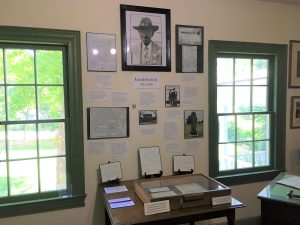
BERLIN – The Calvin B. Taylor House Museum kicked off the 2020 season last week with a new exhibit highlighting a slave who got his freedom in exchange for fighting in the Civil War.
Delayed by the ongoing COVID-19 situation, the Taylor House Museum opened to the public July 1 for the 2020 season. Museum representatives are eager to show off the Taylor House’s newest exhibit, a multimedia display about Isaiah Fassett, a Berlin native who was released from slavery on the condition that he join the Union Army in 1863.
“We feel it is an important thing right now to be telling the story of the entirety of Berlin,” said Melissa Reid, president of the Taylor House Museum. “Isaiah Fassett is an amazing historical figure from Berlin.”
Reid said plans were underway for an exhibit about Fassett several months ago when Rev. David Briddell, one of Fassett’s descendants, offered to provide the museum with additional photos and documentation. Briddell and his wife Jane also introduced museum officials to Berlin resident Gregory Purnell, who was able to provide narration for the display.
“It’s dramatically changed the way the information is presented,” Reid said. “It’s become a story that’s much more dynamic and meaningful and purposeful than just the words.”
Jane Briddell agreed that the narration brought the exhibit to life.
“Hearing it makes it much more real,” she said.
The Briddells, who published a history of the Fassett, Waters and Briddell families a few years ago, were eager to help share the story of Isaiah Fassett.
“Isaiah even now is a very well-known person in Berlin, particularly within the African American community,” Jane Briddell said.
Fassett was born a slave in Berlin in 1844. He and his three brothers were released from slavery in 1863 by Sarah Bruff, who was given $300 per slave for them to enlist in the Union Army. Fassett and his brothers received no compensation for enlisting.
Jane Briddell said the government started compensating slaveholders to free their slaves when the president realized he needed more people to fight if the Union Army was going to win the Civil War.
“If that hadn’t happened the Union Army would have lost the battle,” Briddell said. “That fact is never highlighted when they talk about the Civil War.”
Fassett went on to fight in South Carolina and Virginia. After Richmond fell, Fassett was promoted to corporal and sent to Texas, Cuba and New Orleans before receiving his discharge in 1866.
Fassett returned to Berlin and became a carpenter. He married and had eight children, building a home on Branch Street. He also served as commander of the Berlin post of the Grand Army of the Republic, an organization of Union Army veterans. Fassett, who lived to be 102 and was the second oldest Civil War veteran in Maryland when he died, is remembered in his later years dressed in his uniform and standing at attention on his porch during the town’s Memorial Day celebration.
“His character survives,” Purnell said. “That’s what heroes are made of. So many fashioned themselves like Isaiah Fassett.”
Briddell said one of her husband’s favorite recollections touches on Fassett’s nickname of Uncle Zear.
“Everyone called him Uncle Zear,” Jane Briddell said. “It wasn’t until David was about 40 that he realized he was actually his uncle.”
Purnell said the nickname was a mark of respect.
“When someone is older and well respected he becomes uncle,” Purnell said.
Purnell said what made the Fassett exhibit stand out at the Taylor House was the fact that Fassett was the only man featured inside that had to fight in a war for his own freedom. He says the museum will be remembered for taking the step to create the exhibit.
“This is a giant step ahead, particularly in this community,” he said.
Purnell, who grew up in Berlin and attended the all-black Worcester High School, remembers well the days of segregation. He recalls the colored bathrooms and sitting in the balcony at The Globe and using the back door to enter establishments.
“This is where Berlin was,” he said. “I remember when they built (Route)113 which at that time, it destroyed a couple of black businesses and came right through the African American community, it wasn’t much spoken of it or whatever because back then people didn’t rock the boat. But it became almost like the Berlin wall.”
Jane Briddell recalls visiting Flower Street the first time to meet her husband’s parents.
“I was the only white person on the street,” she said, adding that that portion of town had only started to change in the last 5-10 years.
Purnell said that Berlin today was far different than the Berlin he experienced growing up.
“Now it’s almost unrecognizable,” he said. “The integration of the community is going off without a hitch…The town is evolving. Berlin now is one beautiful community.”
Reid said the Fassett exhibit was an attempt to ensure the museum was sharing all of the town’s history.
“This is a step along the road toward telling many more stories,” she said.
Purnell applauded the effort.
“It opens the door for more of a complete history to be told,” he said. “The exhibits here, when the entire history is told here and you can come and see this history of Berlin and how it has manifested, that’s what a museum is about.”
The Taylor House Museum is now open for tours Monday, Wednesday, Friday and Saturday between 11 a.m. and 3 p.m. Visitors are asked to call in advance to schedule a tour or sign up at the museum entrance. For more information visit www.taylorhousemuseum.org.

